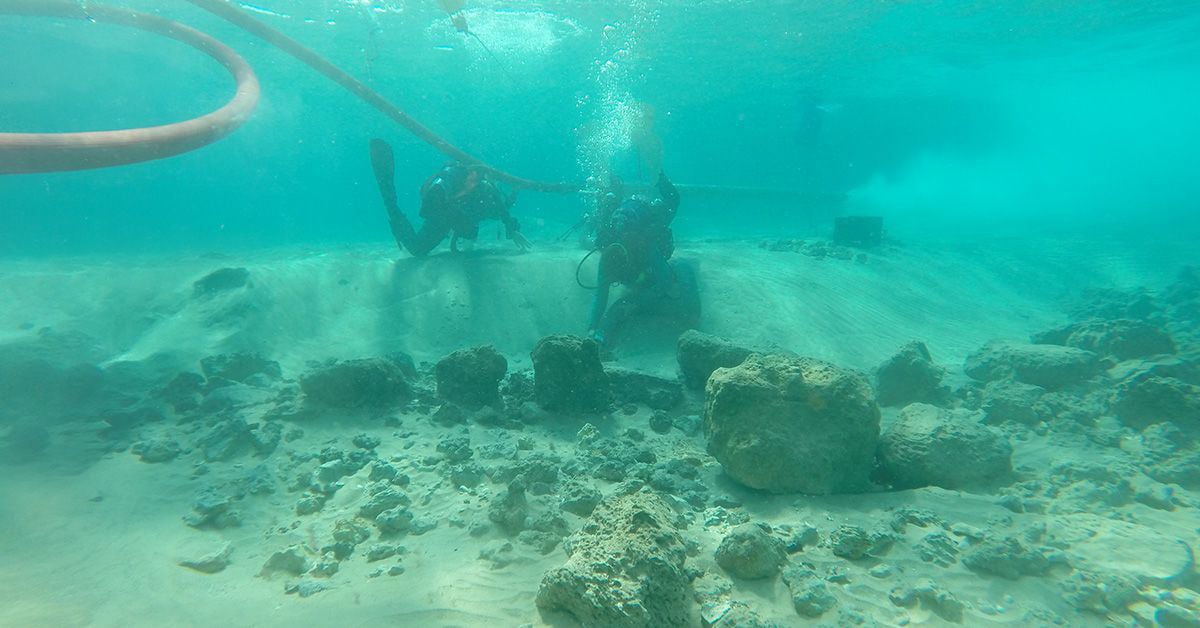Divers on a research team examine architectural remains at the underwater village of Habonim North, off Israel’s Carmel Coast. Credit: University of California – San Diego
An underwater excavation has uncovered evidence of human resilience during the climate changes of the Neolithic period.
Around 6,200 BCE, the climate underwent significant changes. Global temperatures fell, sea levels rose, and the southern Levant—comprising present-day Israel, the Palestinian territories, Jordan, Lebanon, southern Syria, and the Sinai desert—experienced a prolonged drought.
Previously, archaeologists believed that this abrupt shift in global climate, called the 8.2ka event, may have led to the widespread abandonment of coastal settlements in the southern Levant. In a recent study published in the journal Antiquity, researchers at UC San Diego, the University of Haifa, and Bar-Ilan University share new evidence suggesting at least one village formerly thought abandoned not only remained occupied, but thrived throughout this period.
“This [study] helped fill a gap in our understanding of the early settlement of the Eastern Mediterranean coastline,” said Thomas Levy, a co-author on the paper, co-director of the Center for Cyber-Archaeology and Sustainability (CCAS) at the UC San Diego Qualcomm Institute (QI)
inaugural holder of the Norma Kershaw Chair in the Archaeology of Ancient Israel and Neighboring Lands in the Department of Anthropology, and a distinguished professor in the university’s Graduate Division. “It deals with human resilience.”
Signs of Life
The village of Habonim North was discovered off Israel’s Carmel Coast in the mid-2010s and later surveyed by a team led by the University of Haifa’s Ehud Arkin Shalev.
Prior to its excavation and analysis, there was scant evidence of human habitation along the southern Levantine coast during the 8.2ka event. The dig, which took place during the COVID-19 lockdown and involved a weeks-long, 24/7 coordinated effort between partners at UC San Diego and the University of Haifa, was the first formal excavation of the submerged site.
Led by Assaf Yasur-Landau, head of the Leon Recanati Institute for Maritime Studies at the University of Haifa, and Roey Nickelsberg, a Ph.D. candidate at the University of Haifa, the international team excavated the site using a combination of sediment dredging and sampling, as well as photogrammetry and 3D modeling. Team members uncovered pottery shards or “sherds”; stone tools, including ceremonial weapons and fishing net weights; animal and plant remains; and architecture.
Using radiocarbon dating, the researchers tested the recovered bones of wild and domesticated animals; the charred seeds of wild plants; crops like wheat and lentils; and weeds that tend to accompany these crops. Their results traced these organic materials back to the Early Pottery Neolithic (EPN), which coincided with both the invention of pottery and the 8.2ka event.
Habonim North’s pottery sherds, stone tools, and architecture likewise dated activity at the site to the EPN and, surprisingly, to the Late Pottery Neolithic, when the village was thought to have been abandoned.
As for how the village likely weathered the worst of the climate instability, the researchers point to signs of an economy that diversified from farming to include maritime culture and trade within a distinct cultural identity. Evidence includes fishing net weights; tools made of basalt, a stone that does not naturally occur along this part of the eastern Mediterranean coast; and a ceremonial mace head.
“[Our study] showed that the Early Pottery Neolithic society [at Habonim North] displayed multi-layered resilience that enabled it to withstand the 8.2ka crisis,” said Assaf Yasur-Landau, senior author on the paper. “I was happily surprised by the richness of the finds, from pottery to organic remains.”
Through 3D “digital twin” technology and the Haifa – UC San Diego QI collaboration, the researchers studying Habonim North have been able to recreate their excavation, virtually, and 3D-print artifacts, opening the path to further study. The team previously received an Innovations in Networking Award for Research Applications from the non-profit organization CENIC for “exemplary” work leveraging high-bandwidth networking during the DOI: 10.15184/aqy.2024.32





















Discussion about this post